
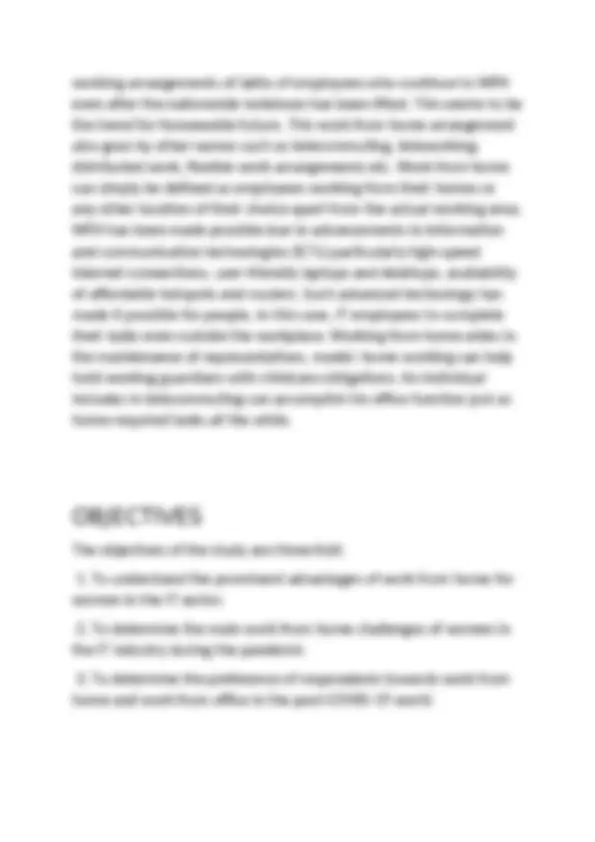
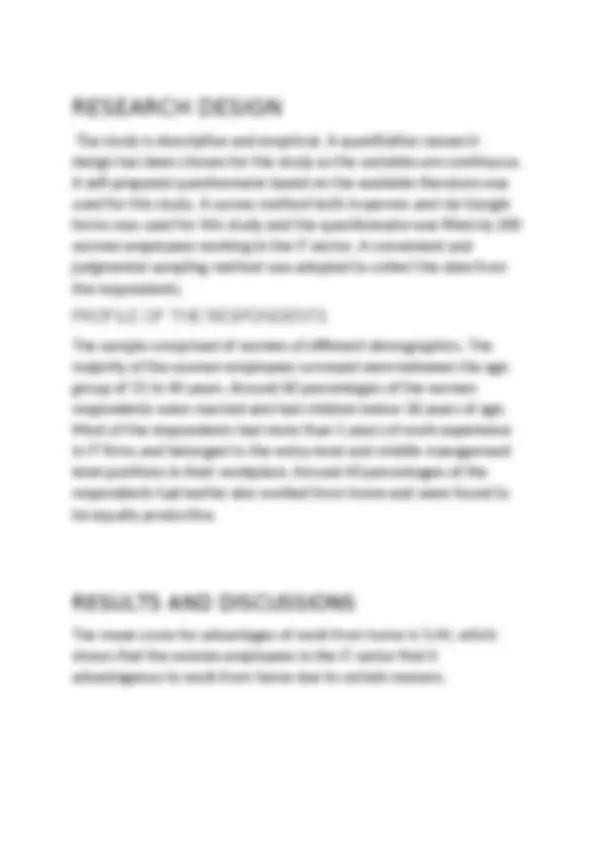
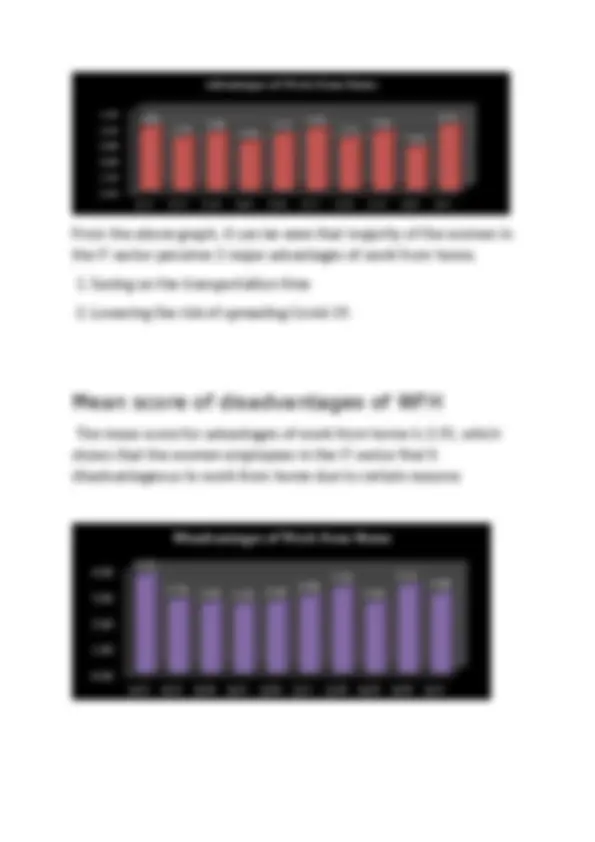
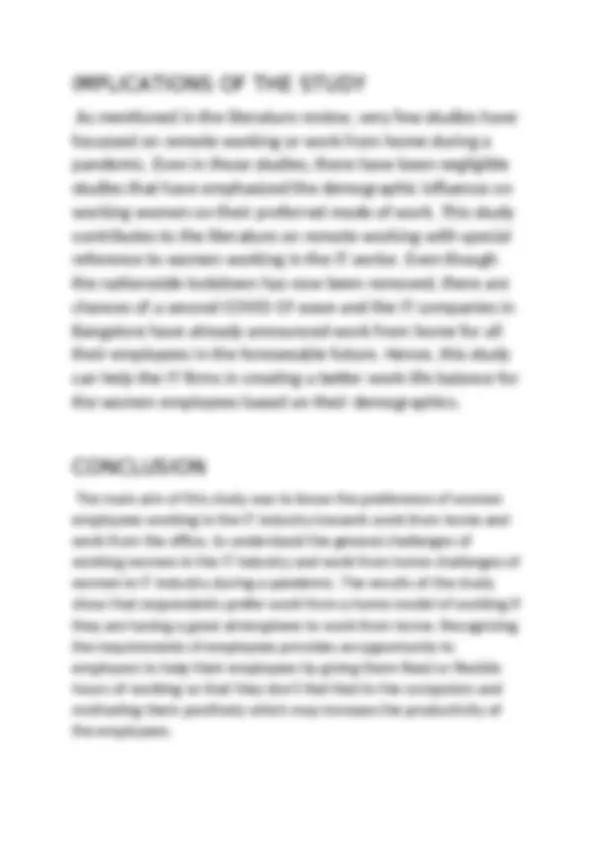
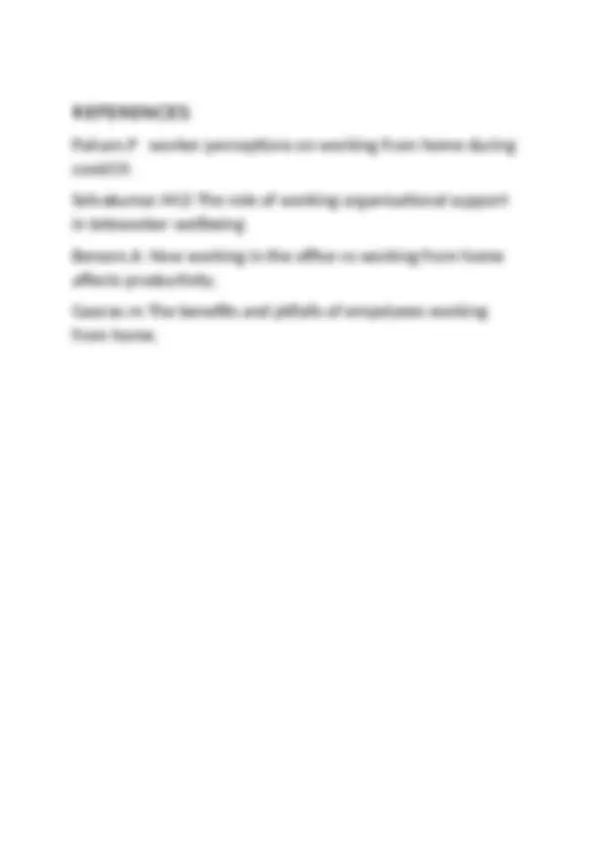


Study with the several resources on Docsity

Earn points by helping other students or get them with a premium plan


Prepare for your exams
Study with the several resources on Docsity

Earn points to download
Earn points by helping other students or get them with a premium plan
Community
Ask the community for help and clear up your study doubts
Discover the best universities in your country according to Docsity users
Free resources
Download our free guides on studying techniques, anxiety management strategies, and thesis advice from Docsity tutors
it is about how the people are get affected because of new rules after covid-19
Typology: Schemes and Mind Maps
1 / 9

This page cannot be seen from the preview
Don't miss anything!






RD
This study examines the perception of IT employees in Bangalore towards Work From Home (WFH) and Work From Office (WFO) SHRI HARISH R S 21bmsr
during the COVID-19 pandemic. The study is descriptive and empirical in nature and a survey method was adopted to collect the data. The questionnaire was self-prepared based on literature and comprised of questions on demographic information of the respondents, current work scenario in the pandemic, challenges at workplace, challenges of work from home and the respondent preference of WFH versus WFO. Through this study, the author intends to identify the mean scores for employee preference towards WFH and WFO and to identify the main advantages and drawbacks of work from home and work from the office. Cronbach alpha was used to measure the reliability of the self-developed questionnaire. Some of the statistical tests carried out in the study were correlation analysis and multiple regression analysis. INTRODUCTION Due to the COVID-19 pandemic, WFH was considered a coveted benefit for IT employees. Many IT organizations worried about how work from home or telecommuting privilege offered to the employees would affect productivity, teamwork and communication. Before the pandemic stuck a mere 14% of the employees were working remotely as per the Indian Labour statistics. However, when the COVID-19 pandemic hit the nation, there was no other option for IT organizations except to announce work from home for all of their employees. The COVID-19 pandemic has steered the employees of not just India but across the globe to stay at home owing to lockdowns happening everywhere and to reduce social contacts to a minimum. Even though telecommuting policies did exist earlier, it was the pandemic that caused this work from home aspect to gain immense popularity not just in the IT sector but across diverse sectors. This pandemic has brought about drastic changes in the
RESEARCH DESIGN The study is descriptive and empirical. A quantitative research design has been chosen for the study as the variables are continuous. A self-prepared questionnaire based on the available literature was used for this study. A survey method both in-person and via Google forms was used for this study and the questionnaire was filled by 200 women employees working in the IT sector. A convenient and judgmental sampling method was adopted to collect the data from the respondents. PROFILE OF THE RESPONDENTS The sample comprised of women of different demographics. The majority of the women employees surveyed were between the age group of 31 to 40 years. Around 60 percentages of the women respondents were married and had children below 18 years of age. Most of the respondents had more than 5 years of work experience in IT firms and belonged to the entry-level and middle management level positions in their workplace. Around 40 percentages of the respondents had earlier also worked from home and were found to be equally productive. RESULTS AND DISCUSSIONS The mean score for advantages of work from home is 3.44, which shows that the women employees in the IT sector find it advantageous to work from home due to certain reasons.
From the above graph, it can be seen that majority of the women in the IT sector perceive 2 major advantages of work from home.
DISCUSSION With a focus towards understanding the preference of women employees working in the IT sector towards work from home and work from the office, a sample of 200 working women employees from the IT sector were chosen. The data were analyzed using chi- square tests and found that preference towards WFH vs. WFO has demographic implications. Similar studies have been conducted recently owing to the pandemic across the world in diverse sectors. Most of these studies to have demographic implications. Raisiene, Rapuano, Varkuleviciute and Stachova (2020), conducted a study on working from home- who is happy? And it was found that telework efficiency depended on many factors such as gender, age, education, work experience, and experience of telework. IMPLICATIONS OF THE STUDY As mentioned in the literature review, very few studies have focussed on remote working or work from home during a pandemic. Even in those studies, there have been negligible studies that have emphasized the demographic influence on working women on their preferred mode of work. This study contributes to the literature on remote working with special reference to women working in the IT sector. Even though the nationwide lockdown has now been removed, there are chances of a second COVID-19 wave and the IT companies in Bangalore have already announced work from home for all their employees in the foreseeable future. Hence, this study can help the IT firms in creating a better work-life balance for the women employees based on their demographics.
IMPLICATIONS OF THE STUDY
CONCLUSION The main aim of this study was to know the preference of women employees working in the IT industry towards work from home and work from the office, to understand the general challenges of working women in the IT industry and work from home challenges of women in IT industry during a pandemic. The results of the study show that respondents prefer work from a home model of working if they are having a good atmosphere to work from home. Recognizing the requirements of employees provides an opportunity to employers to help their employees by giving them fixed or flexible hours of working so that they don’t feel tied to the computers and motivating them positively which may increase the productivity of the employees.